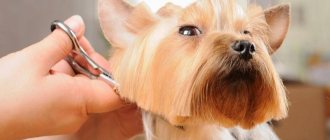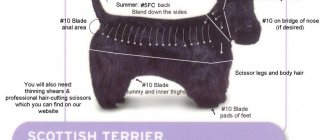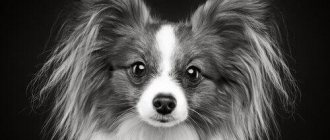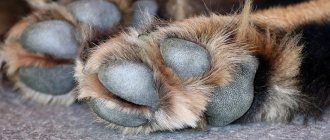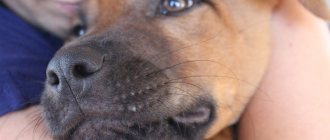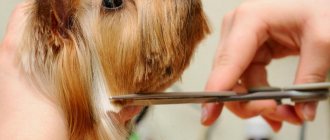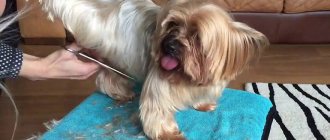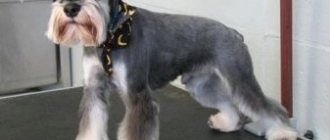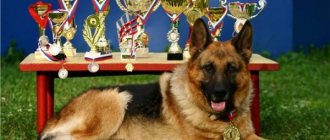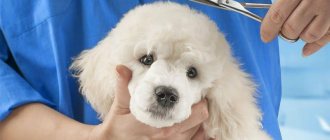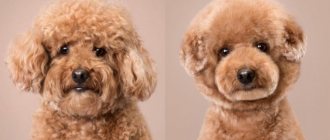Grooming dogs at home is a very responsible activity, which affects the appearance, comfort and health of the pet. If you have a show-class animal, it is better to entrust the task to a groomer: the smallest detail is important at the exhibition. If a hygienic haircut is needed, the owner can do it himself. Fortunately, there are a lot of training videos on the Internet on how to properly trim a dog at home. You can also take a grooming course under the supervision of a highly qualified master.
Why does a dog need a haircut?
Wool protects the pet from cold, heat, and aggressive environmental influences. But in order for it to cope with the task, it must be properly looked after - the pile must be clean, dry, without lumps, otherwise problems are possible.
Tangled, lifelessly hanging strands provide poor warmth in winter and float in summer. Ungroomed fur can turn into a dense, hard coat that can impair blood circulation, hide cysts, dermatitis, skin irritation, hives and other skin diseases. It is more difficult for owners to detect ticks and deal with fleas.
Clumps of fur around the anus can cause feces to dry out, preventing bowel movements. Dirt near the anus is ideal conditions for bacteria, which can then enter the dog’s intestines.
Types of dog haircuts
- Hygienic is a simple procedure that allows your pet to look neat and well-groomed. This option is recommended if you need to trim your dog’s hair at home yourself. The procedure involves removing tangles, plucking hairs in the ears, between the fingers, and near the intimate area.
- Exhibition – the service is necessary if the animal is regularly exhibited. To trim a dog's coat, the groomer follows the rules recommended for the given breed.
- Trimming is a procedure necessary for dogs with hard hair (wire-haired terriers, schnauzers, Jack Russells) that do not have a period of shedding. The job is to evenly remove dead guard hairs.
- Pedigree - a pet is cut not for an exhibition, but “for oneself”, taking into account the characteristics of the breed. This haircut emphasizes the natural beauty and dignity of the dog.
- Model (creative) - to give the pet originality, the groomer resorts to interesting techniques, incl. to coloring, use of rhinestones, sparkles.
CREATIVE
| Services list | Time | Cost, rub. |
| Simple ornament | 20 minutes. | 400 |
| Complex ornament | from 40 min. | from 800 |
| Coating claws with varnish | from 30 min. 2 paws, from 45 min. 4 paws | 600/1000 |
| Decoration with rhinestones | — | 50 rub./one rhinestone |
| Coat color | from 60 min. | by agreement with the master |
| Chinchilla haircut | when ordering a full set | 3000 |
| Fish-ka haircut (Goldfish) | when ordering a full set | 3500 |
| Korean style haircut | when ordering a full set | from 2500 |
What you need to know about wool before cutting your dog's hair
The variety of coats of dogs is explained by the climatic conditions where this or that breed appeared. At the same time, wool is structured differently than human hair. If we have one hair growing from one follicle, in pets from one follicle sprout from 5 to 22 hairs - one main one, the rest are downy. The density of the fur varies in different areas of the skin.
Dogs have the following types of hair:
- Undercoat is the bottom layer of wool, which reduces heat transfer from the body. It is short, soft, thin, slightly wavy, reminiscent of down. In dogs of northern breeds, the undercoat fits tightly to the skin, and the wind does not blow it through. In southern animals it is rare, short, and may be completely absent.
- Guard hair – protects the undercoat from water. In dogs that live in warm conditions, it fits tightly to the body, which makes the animal smooth-haired.
- The outer coat is the longest and stiffest, protecting the most vulnerable areas of the skin. In some breeds it creates eyebrows, mustaches, and beards. The outer hair protects the animal from direct sunlight, which can cause heat stroke and skin burns.
- Tactile hair. They are located under the eyes, on the cheeks, upper lip, under the lower jaw.
The appearance of the dog depends on the guard and integumentary hairs, which tightly fit the body. Boxers have smooth coats, Shih Tzus have long coats, and Poodles have curly coats. Short-haired breeds include Labradors, Staffordshire Terriers, and German Shepherds. Huskies are considered to have medium length hair. Breeds with long hair - collies, Samoyeds.
Tools and care products
The key to a successful and beautiful hairstyle is a quality tool. What can't you do without when grooming?
- scissors - straight and rounded, large and small;
- dog machine; You can, of course, try human hair, but the structure of wool and hair is different, so it’s better to get a special tool;
- thinning scissors, if thinning is required;
- wide-tooth comb and brush;
- slicker if the animal has a voluminous undercoat;
- hair dryer;
- a tangle cutter will come in handy if the felt boot can no longer be disassembled with a comb;
- nail clipper for manicure, two types to choose from: guillotine or nippers.
As for care products, you will need shampoo for the type of coat your dog has, optional conditioner, peroxide or chlorhexidine, just in case. During show trim, fixing agents are often used - foams, mousses and varnishes.
Peculiarities of animal grooming, depending on wool
Animals with medium and long hair, as well as pets with short curly hair, need a haircut. It is important to remember that your pet should be cut, not shaved. The doctor resorts to the second option before surgery, for skin diseases.
The following breeds need to be trimmed:
- American Cocker Spaniels. How often should a dog of this breed be cut? The recommended number of procedures is 4 times a year.
- Miniature Schnauzers have hard, wire-like hair. They are not cut, but trimmed - dead hairs are plucked out.
- Terriers with medium or long hair can be cut or trimmed.
- Pekingese - special attention should be paid to the hair between the toe pads.
- Pomeranian Spitz - the procedure helps to enhance hair growth.
It is recommended to cut with scissors animals without undercoat with long, fast-growing hair - poodle, shih tzu, Yorkshire terrier. If the coat is not taken care of, the tangles form a dense, hard fabric, which can only be removed by a radical haircut.
Which dogs should not be cut?
Pets with short, smooth hair (Staffordshire Terrier, Boxer, etc.) do not need a home grooming. Their fur protects them from the cold in winter and from the heat in summer. There is also no need to shave the dog, otherwise the pet may get heatstroke. It is enough to limit yourself to caring for the dog’s ears, claws, eyes, and combing out the hairs during shedding.
Dogs with a dense undercoat do not need clippers. On the contrary, the procedure can cause baldness. The list of breeds that are prohibited from grooming includes northern breeds (huskies, malamutes), herding breeds (German and Belgian shepherds, mastiffs, border collies), and hunting breeds (labradors).
What precautions should you take?
When grooming a dog, especially without sufficient experience, you should be extremely careful not to injure your pet. To do this, remember that:
- You can't cut the wool completely, to zero. If there is an urgent need for this, it is better to turn to a professional.
- Particular attention is paid to pets who are not accustomed to haircuts, who are undergoing this procedure for the first time or very rarely.
- Carefully groom extremely active dogs that are unable to sit still for a minute.
- In case of injury, do not let go of the pet, confidently and calmly hold it in place, quickly treat the wound with hydrogen peroxide, Chlorhexidine or Miramistin.
- If the eyes or mucous surfaces are damaged, immediately take the animal to the nearest veterinary clinic.
Basic rules for dog grooming
- Before you start work, decide on the type of haircut - do you want to simply remove excess hair with a clipper or make a model version.
- It is better to cut the intimate area with a clipper with a 4-5 mm attachment. If you use scissors, the blade should be pointed downward to prevent your pet from getting hurt.
- The dog must be groomed on a table with a non-slip surface.
- The animal must stand while working.
- Remove hair on the face and ears carefully. If you hurt your pet, the animal will be afraid of the procedure.
- Don't remove too much lint in the summer. The dog may suffer heatstroke or burns.
- If your pet has long hair, pay attention to the animal's paws. Dirt, snow, and hair can accumulate between your toes, causing pain. Trim these areas promptly.
- If you are a beginner, first learn how to cut with scissors, only then with a clipper.
- The dog should be cut along the hair growth, except for the paws and between the toes. This way you won't hurt the animal if it jerks.
Rules for beginners
There are some points that must be observed for the safety of your pet:
- It is better to secure the pet. Grooming tables provide this opportunity - they are secured with a noose on a special stand and have an anti-slip coating. If buying a grooming table is not in your plans, use a rubber mat and an assistant who will restrain an animal that does not want to stand still.
- The machine needs to be moved parallel to the skin along the hair growth. When there are folds, they are straightened out - and only after that they are cut so as not to injure the skin and cut to the same length.
- Trim only a dry and washed animal if you do not want to dull and damage the tool.
- When the process is finished, check to see if the skin is damaged. If there are wounds, they must be disinfected with special powder or chlorhexidine.
- Nails need to be trimmed very carefully, especially when they are dark in color. Keep hemostatic powder or at least hydrogen peroxide ready, as even experienced groomers have such incidents.
The entire tool must be well sharpened, otherwise it will tug and pull the wool, causing unpleasant sensations and forming not the best associations with the haircut. Clippers and scissors should be stored dry and closed.
How to train a dog to get a haircut
Pets often don’t like having their tail, ears, and belly cut. They twitch and become restless. How to properly groom a dog in these conditions? To keep your dog from worrying, get your puppy used to clipper haircuts as soon as you get him:
- Before you cut your dog's hair at home, teach your dog to comb his hair. Place it on a non-slip hard surface, run the brush through the pile with the words “combing.” Then give him a treat and let him go for a walk.
- Get used to scissors. When the baby is used to combing, take scissors and imitate a haircut, cutting off micro-fragments of hairs. During the procedure, say: “let’s get a haircut,” and give a treat at the end.
- Train your puppy to use the machine. Dry your hair with a hair dryer in front of him so that he is not afraid of the hum of an electrical appliance.
If you are cutting your adult pet's hair for the first time, before cutting the lock, stroke it behind the ear (near the tail, belly). How to cut a dog's hair if it won't cut it? Do not use force as the fear may worsen. A trusting relationship with your pet will help you cope with the problem. Be sure to praise the dog for its obedience and give it a treat.
Possible problems
No matter how correctly the job is done, you may encounter a number of problems in the process of grooming your pet. You can solve them if you know how to act in a given situation. What to do if the dog becomes aggressive and bites? What to do when your dog won’t let you cut his hair? How to cope with grooming an animal whose fur is very fluffy and very tangled?
What to do with an aggressive, biting dog?
Before starting the procedure, the dog needs to be walked and fed. It would be a good idea to give him some kind of treat. Excitement, screaming, sudden movements can quickly be transmitted to the dog, making it angry. If during the procedure the pet becomes aggressive and biting, attempts to cut it should be stopped and your four-legged friend should be calmed down. You can try to cut the animal again no earlier than in a week.
During this period, it is necessary to accustom him to good behavior during any manipulations with the fur. While pretending to cut the dog's hair, the owner should treat him to something tasty. There are dogs that only experienced groomers can groom. These are representatives of the dominant and nervous types. Large and particularly aggressive dogs are muzzled before the procedure begins.
Preparing to groom your pet
Before you groom your dog at home, set up a grooming area. The table on which the dog will stand should not slide (place a rubber mat). Its height should correspond to the height of the make-up artist so that it is convenient to work.
Before cutting your dog's hair at home, make sure that all tools are in good working order and work well, and that the knives are sharpened. Unsuccessful attempts to cut a tuft of fur can injure the animal.
Give your pet a bath a day or two before grooming your dog at home with scissors. Dirty hair is difficult to work with. If you decide to wash your animal before grooming, the coat must be completely dry. You can't cut a wet dog's hair. It will be difficult to evaluate the results; the blades of the machine will become dull.
Why is grooming popular?
Professional dog grooming in a salon comes with a number of benefits. The key ones are:
- individual approach;
- variety of professional tools;
- understanding the peculiarities of working with a particular breed;
- haircut according to established requirements;
- approach to any animal;
- a full range of hygiene procedures;
- discounts for regular customers.
Dog grooming is not just a service, it is a real way to decorate the animal and maintain the condition of the coat in proper condition.
How to cut a dog's hair with scissors
Before you cut your dog’s hair at home with scissors, you need to comb your pet, remove tangles and split ends. Then you can start cutting/plucking hair from the main areas - ears, pads between the fingers, around the eyes, intimate area.
When working with the muzzle, cover the mouth with your hand so that the dog does not accidentally bite. Before trimming the hair between your dogs' toes, use sharp, narrow-bladed scissors. They will help you get to hard-to-reach places. At the final stage, you can move on to the body.
Step by step procedure at home
After the preparation has been completed, you can proceed to the main stage. At first everything may seem long, but in reality the procedure flies by.
So, everything in order:
- It is better to start a hygienic haircut with the least favorite procedure - trimming nails. Immediately after this, small scissors with rounded tips are used to cut out all excess between the fingers and pads, forming a neat round foot.
- The second step is to move to the head. Here the inside of the ears is trimmed, and the muzzle is shaped in accordance with the requirements of the breed.
- From the head a smooth transition is made along the neck to the shoulders and body.
- The groin is shaved with a clipper; boys are sometimes left with a “curtain” that covers their dignity.
- Along the body, the owner leaves the length that he wants, and depending on this, he works with a machine or evens out the bottom line with scissors.
- Small feathering is left on the paws or they form columns, like those of poodles. The tail is usually left brushed unless docked.
- The last step is to create a top note (“bun” from the bangs), if necessary. It is very important to tie the elastic bands and ponytails correctly and not to overtighten the ear - part may die and fall off.
The full length of the coat is rarely left during a hygienic haircut: usually it is cut short or a skirt of medium length is left. After the procedure, it is recommended to bathe your pet again to wash away short, prickly hairs and avoid skin irritation.
How to cut a dog's hair with a clipper
Is it possible to cut a dog's hair with a human clipper? No. The device must be specifically designed for use by animals. Human hair devices can injure your dog and remove too much hair, leaving bald patches.
A dog clipper at home can be battery-powered or powered from the mains. There are options where both options are provided. Knives can be removable or permanent. Choose devices that have different attachments. They protect the dog from cuts and also help cut hairs of various lengths.
Before cutting your dog's hair with a clipper, carefully read the instructions that come with each device. The machine should be moved along the skin, without pressing. If the dog has skin folds, they should be smoothed out with your fingers, and only then the area should be trimmed.
Before you cut your dog’s hair at home with a clipper, know that skills in working with electrical appliances take years to acquire. Therefore, you need to be prepared for the fact that you may not get a cool hairstyle for your dog right away. If you are a beginner, it is better to start with scissors.
Possible difficulties when cutting
If the dog does not like being cut with scissors or a clipper, he may growl. How to cut a dog's hair if it bites? Accustom her to the procedure as if you were working with a puppy - step by step, not forgetting to praise and give a treat.
To avoid injury, the animal should move as little as possible. If you need to reach hard-to-reach places or change the angle of the tool, it is better for the groomer to change the position.
When trimming claws, you can injure the animal if you accidentally touch a live area. Buy a hemostatic powder in advance, which not only stops the bleeding, but also disinfects the wound.
HARD HAIR BREEDS
| Breed name | Haircut time | Cost of services, rub. | ||
| Haircut 3? | Full complex1? | Full complex + trimming4? | ||
| Scotch Terrier | 2-2.5 hours | — | 3500 | 4000 |
| Brussels Griffon | 1.5-2.5 hours | — | 2600 | 3000 promotion for puppies |
| Welsh Terrier | 2.5-3 hours | — | — | 4000 promotion for puppies |
| West Highland White Terrier | 2-2.5 hours | — | 3500 | 4000 |
| Jack Russell Terrier | 2.5-3 hours | — | — | 3500 |
| Irish Terrier | 3-3.5 hours | — | — | 4500 |
| Norwich Terrier, Norfolk Terrier, Cairn Terrier | 2.5-3 hours | — | — | from 3000 |
| Wire-haired dachshund | 2-2.5 hours | — | 3000 | 3500 |
| Fox terrier | 2.5-3 hours | — | — | from 4000 |
| Airedale | 3.5-4 hours | — | 4000 | 5000 |
| Giant Schnauzer | 3.5-4 hours | 3500 | 4800/cosmetics | 6000 promotion for puppies |
| Miniature Schnauzer | 2.5-3 hours | — | 4200/cosmetics | 5500 promotion for puppies |
| Master breed schnauzer/master all-rounder Miniature Schnauzer up to 38 cm (standard) | 2-2.5 hours | — | 4000 (rolling, cosmetics)/3000 | 4500/3500 promotion for puppies |
| Miniature Schnauzer over 38 cm at the withers | 2-2.5 hours | — | 4200 (rolling, cosmetics)/3200 | 4800 /3800 promotion for puppies |
